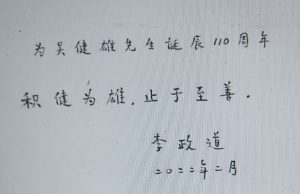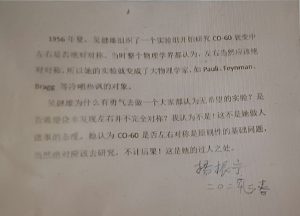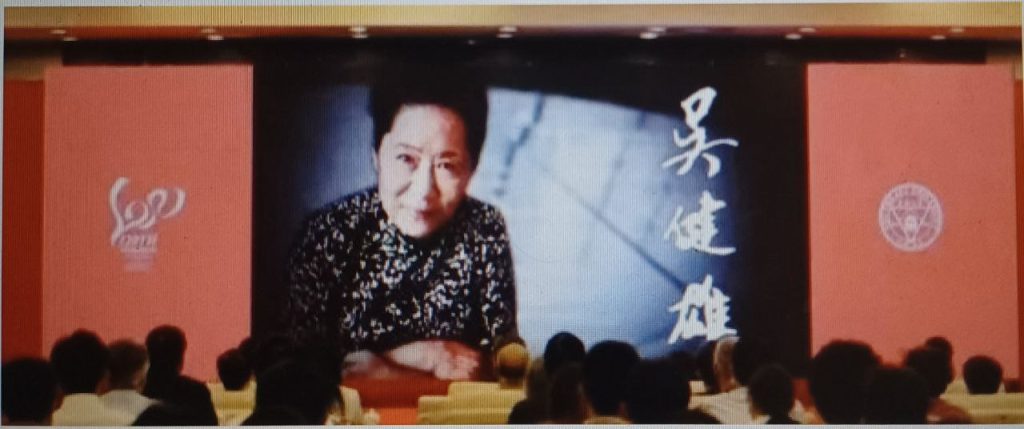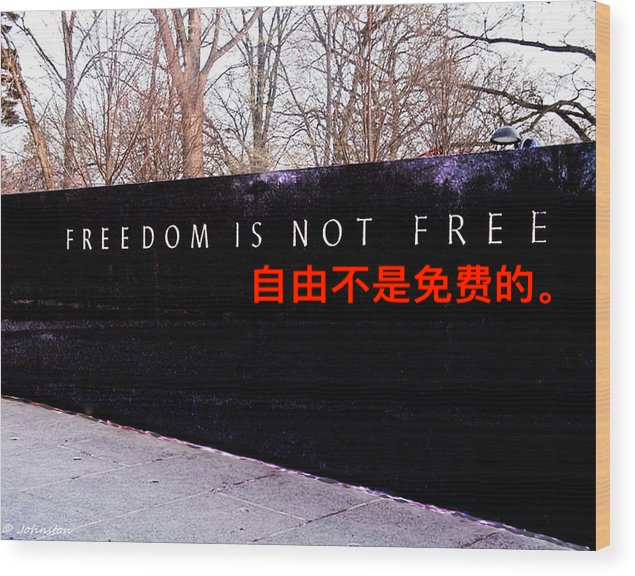May 31, 2022 commemorative event site
May 31, 2022 is the 110th birthday anniversary of Mr. Wu Jianxiong. Relevant organizations held a grand commemorative event in Wu Jianxiong’s hometown, Taicang City, Jiangsu Province. Mr. Li Zhengdao and Mr. Yang Zhenning both sent people to send commemorative texts. Li Zhengdao’s commemorative text is:
On the 110th birthday of Mr. Wu Jianxiong
Accumulate health as a hero, stop at perfection
Li Zhengdao
February 2022
Yang Zhenning’s commemorative text is:
In the summer of 1956 , Wu Jianxiong organized an experimental group to study whether the left and right are absolutely symmetrical in the decay of CO-60 (nucleus of cobalt 60) . At that time, the entire physics community believed that, of course, the left and right should be absolutely symmetrical, so her experiments became the object of cynicism from big physicists such as Pauli, Feynman, Bragg , etc.
Why did Wu Jianxiong have the courage to do an experiment that everyone thought was hopeless? Want to get away with finding that the left and right are not perfectly symmetrical? I don’t think so! This is not how she behaves. She believes that whether CO-60 is symmetrical or not is a fundamental question of principle, and of course it should be studied regardless of the consequences! This is her brilliance.
Yang Zhenning
Spring 2022


The great physicist Pauli mentioned by Mr. Yang Zhenning is Professor Wolfgang Pauli, who won the Nobel Prize in Physics in 1945 . Regarding Pauli, I would like to make two very brief introductions. One is that in 1924 he got a quantum mechanical principle – the Pauli exclusion principle: there cannot be two or more fermions in the same state. Second, in 1930 , he put forward the hypothesis of the existence of “Pauli neutrons” (neutrinos) out of his firm belief in the law of conservation of energy. Twenty-six years later, in 1956 , neutrinos were directly detected for the first time in experiments by American physicists Cowan and Reines ; the law of conservation of energy was again proved not to be a prejudice .
In the summer of 1956 , when he learned that Wu Jianxiong was going to use experiments to test whether the left and right were symmetrical or not, Pauli, who believed that the principle of left and right symmetry was universal, said: “A good experimental physicist like Wu Jianxiong should find some important people. Don’t waste time on the obvious. Everyone knows that parity must be conserved.”

Wolfgang Pauli writing equations on a blackboard , 1953
The great physicist Feynman mentioned by Mr. Yang Zhenning is Professor Richard Feynman, who won the Nobel Prize in Physics in 1965 . What did he say again in the summer of 1956 ? Feynman said the Wu Jianxiong experiment “was a crazy experiment, and you don’t need to waste time on it.” He also suggested betting 10,000 to 1 that the experiment would never work.
The great physicist Bragg mentioned by Mr. Yang Zhenning is Professor William Lawrence Bragg, who won the Nobel Prize in Physics in 1915 . Unfortunately, I could not find any relevant information about Bragg’s “cynicism” about Wu Jianxiong’s experiment.


Richard Feynman is the brilliant, ever William Lawrence Bragg
The most prolific science teacher at 25 with his father William Henry Bragg
Shared the 1915 Nobel Prize in Physics
Half a year later, in January 1957 , the great physicist Pauli conceded defeat in the face of the experimental result of “parity non-conservation”. On January 19 , he personally wrote a letter to Wu Jianxiong to congratulate her on her success, accepting the subversive conclusion that “the left and right are no longer symmetrical in the weak interaction”. Feynman, the great physicist, also graciously admitted that he was a loser. Regarding the main contributions made by Li Zhengdao and Yang Zhenning on the problem of parity, and the “first evidence” provided by Wu Jianxiong’s experiment for “parity non-conservation”, American theoretical physicist Abraham Pais The historian’s eloquent tone, wrote at the end of 1957 : The principle was again judged to be a prejudice .
It has been 65 years since Pauli and Feynman bowed their heads and conceded defeat . Pauli died in 1958 , the year after he conceded defeat. However, Pauli left this world with a deep confusion; his confusion was: “Why does nature only allow parity conservation to fail in weak interactions, but still hold in strong interactions?”
Pauli and Feynman would never have predicted during their lifetimes, and neither did the global physics community for 65 years. Today, 65 years later, there will be a native Chinese who will openly shout grievances for Pauli and Feynman, and complain about it. To make a new ruling for the “iron case” 65 years ago – Pauli and Feynman’s belief in the principle of left-right symmetry is completely correct; the principle of left-right symmetry is a universally correct principle, not a ” a prejudice .”
It is now known that the main contribution of Li Zhengdao and Yang Zhenning on whether the left and right are symmetrical in the weak interaction is to point out that the key is to measure a physical quantity called “pseudoscalar”, and the actual performance of this physical quantity will be given. The decisive result as to whether the left and right are symmetrical. Wu Jianxiong’s main contribution is to take the lead in measuring the relevant pseudoscalar terms in the decay of the cobalt 60 nucleus according to the experimental principle proposed by Li Zhengdao and Yang Zhenning , and immediately announced that the experimental results undoubtedly proved that the weak The left and right are not symmetrical in the interaction.
It is conceivable that Pauli and Feynman, who, like the entire physics community, believe in the existence of pseudoscalars under left-right transformations, are absolutely unable to question the theoretical contributions of Li Zhengdao and Yang Zhenning, and the experimental judgment of Wu Jianxiong. All they can do is, with deep confusion, accept the new gospel of “parity non-conservation” that is quickly spreading around the world.
Today, the reason why I have the courage and ability to retrial and give a retrial ruling on the old koan 65 years ago is because I have rejected the important concepts in left-right transformation—pseudovector and pseudoscalar (For details, please refer to my monograph – “New Theory of Discrete Symmetry in Physics”, published in May 2022 ). If my denial is correct, I have the following verdict:
According to the existing theory, whether the left and right are symmetrical in the weak interaction depends entirely on the performance of the pseudoscalar. That is to say, if there are only scalars and no pseudoscalars in the weak interaction, the left-right symmetry is perfectly guaranteed.
Based on my theoretical results, there is no pseudoscalar under the left-right transformation. From this, it can be asserted that, like in the other three interactions, the left and right are symmetrical in the weak interaction. Therefore, Li Zhengdao and Yang Zhenning’s suggestion of measuring pseudoscalars is a misunderstanding that cannot be established. The measurement of the so-called “pseudoscalar” in Wu Jianxiong’s experiment is actually a measurement of a scalar. Under the left-right transformation, the difference between a scalar and a pseudoscalar is extremely simple and obvious, that is, there is only one minus sign: the scalar remains unchanged, while the pseudoscalar changes its sign. Obviously, when the symbols in Wu Jianxiong’s measurement results are changed, the fact that he proves is precisely that the left and right symmetry is alive and well.
After the judgment is made, we should also talk about friendship. My hometown, Changshu, is adjacent to Taicang. It is no exaggeration for me to call Mr. Wu Jianxiong a fellow. However, in the face of scientific issues, all I want to say is: I love my teacher, but I love the truth more; I love my fellow villagers, but I love the truth more.
July 10 , 2022 at home in Beijing
(This article only represents the author’s personal views and positions, please indicate the source for reprinting, thank you)


